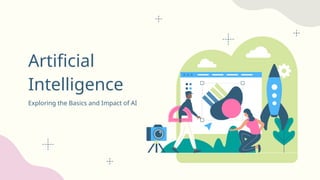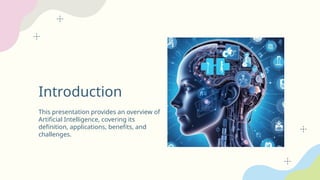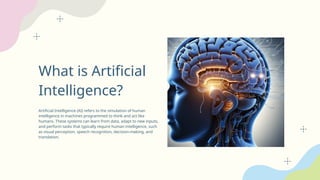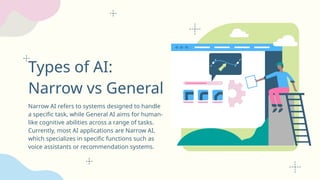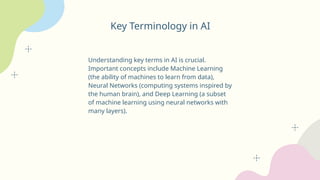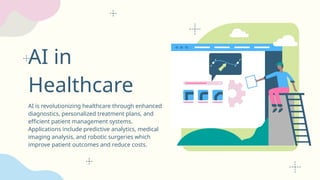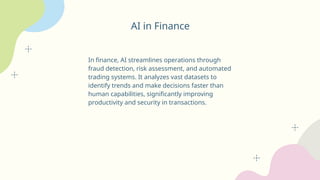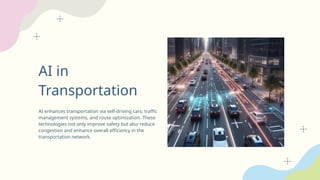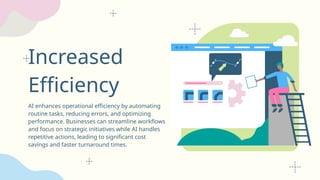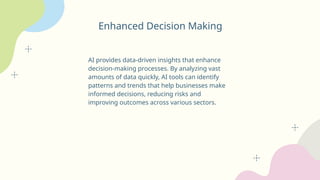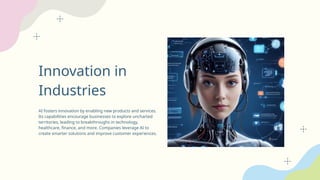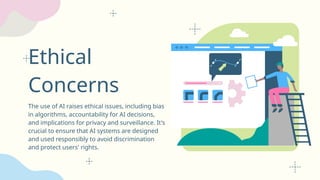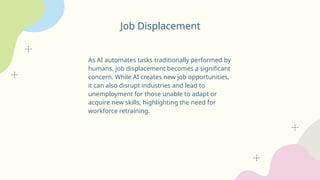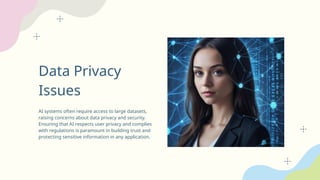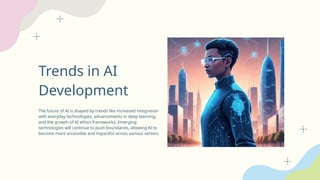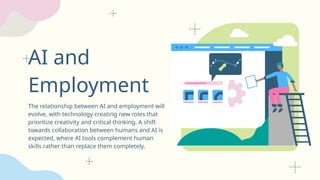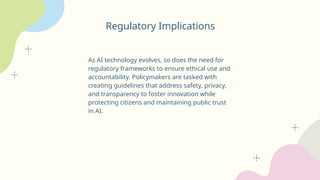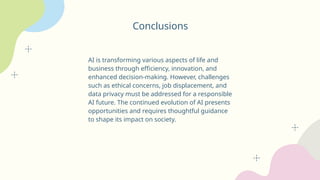Cadence Fidelity Pointwise Crack 2024.1 Full version 2025
- 1. Exploring the Basics and Impact of AI Artificial Intelligence
- 2. Introduction This presentation provides an overview of Artificial Intelligence, covering its definition, applications, benefits, and challenges.
- 4. What is Artificial Intelligence? Artificial Intelligence (AI) refers to the simulation of human intelligence in machines programmed to think and act like humans. These systems can learn from data, adapt to new inputs, and perform tasks that typically require human intelligence, such as visual perception, speech recognition, decision-making, and translation.
- 5. Types of AI: Narrow vs General Narrow AI refers to systems designed to handle a specific task, while General AI aims for human- like cognitive abilities across a range of tasks. Currently, most AI applications are Narrow AI, which specializes in specific functions such as voice assistants or recommendation systems.
- 6. Key Terminology in AI Understanding key terms in AI is crucial. Important concepts include Machine Learning (the ability of machines to learn from data), Neural Networks (computing systems inspired by the human brain), and Deep Learning (a subset of machine learning using neural networks with many layers).
- 8. AI in Healthcare AI is revolutionizing healthcare through enhanced diagnostics, personalized treatment plans, and efficient patient management systems. Applications include predictive analytics, medical imaging analysis, and robotic surgeries which improve patient outcomes and reduce costs.
- 9. AI in Finance In finance, AI streamlines operations through fraud detection, risk assessment, and automated trading systems. It analyzes vast datasets to identify trends and make decisions faster than human capabilities, significantly improving productivity and security in transactions.
- 10. AI in Transportation AI enhances transportation via self-driving cars, traffic management systems, and route optimization. These technologies not only improve safety but also reduce congestion and enhance overall efficiency in the transportation network.
- 11. Benefits 03
- 12. Increased Efficiency AI enhances operational efficiency by automating routine tasks, reducing errors, and optimizing performance. Businesses can streamline workflows and focus on strategic initiatives while AI handles repetitive actions, leading to significant cost savings and faster turnaround times.
- 13. Enhanced Decision Making AI provides data-driven insights that enhance decision-making processes. By analyzing vast amounts of data quickly, AI tools can identify patterns and trends that help businesses make informed decisions, reducing risks and improving outcomes across various sectors.
- 14. Innovation in Industries AI fosters innovation by enabling new products and services. Its capabilities encourage businesses to explore uncharted territories, leading to breakthroughs in technology, healthcare, finance, and more. Companies leverage AI to create smarter solutions and improve customer experiences.
- 15. Challenges 04
- 16. Ethical Concerns The use of AI raises ethical issues, including bias in algorithms, accountability for AI decisions, and implications for privacy and surveillance. It's crucial to ensure that AI systems are designed and used responsibly to avoid discrimination and protect users' rights.
- 17. Job Displacement As AI automates tasks traditionally performed by humans, job displacement becomes a significant concern. While AI creates new job opportunities, it can also disrupt industries and lead to unemployment for those unable to adapt or acquire new skills, highlighting the need for workforce retraining.
- 18. Data Privacy Issues AI systems often require access to large datasets, raising concerns about data privacy and security. Ensuring that AI respects user privacy and complies with regulations is paramount in building trust and protecting sensitive information in any application.
- 19. Future 05
- 20. Trends in AI Development The future of AI is shaped by trends like increased integration with everyday technologies, advancements in deep learning, and the growth of AI ethics frameworks. Emerging technologies will continue to push boundaries, allowing AI to become more accessible and impactful across various sectors.
- 21. AI and Employment The relationship between AI and employment will evolve, with technology creating new roles that prioritize creativity and critical thinking. A shift towards collaboration between humans and AI is expected, where AI tools complement human skills rather than replace them completely.
- 22. Regulatory Implications As AI technology evolves, so does the need for regulatory frameworks to ensure ethical use and accountability. Policymakers are tasked with creating guidelines that address safety, privacy, and transparency to foster innovation while protecting citizens and maintaining public trust in AI.
- 23. Conclusions AI is transforming various aspects of life and business through efficiency, innovation, and enhanced decision-making. However, challenges such as ethical concerns, job displacement, and data privacy must be addressed for a responsible AI future. The continued evolution of AI presents opportunities and requires thoughtful guidance to shape its impact on society.
- 24. CREDITS: This presentation template was created by ºİºİߣsgo, and includes icons, infographics & images by Freepik Do you have any questions? Thank you!
